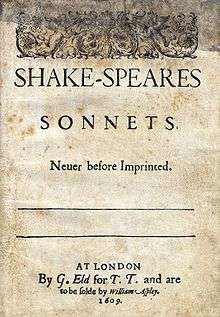Sonnet 31
Sonnet 31 is one of 154 sonnets written by the English playwright and poet William Shakespeare. It is a sonnet within the Fair Youth sequence. Developing an idea introduced at the end of Sonnet 30, this poem figures the young man's superiority in terms of the possession of all the love the speaker has ever experienced.
| Sonnet 31 | |||||||
|---|---|---|---|---|---|---|---|
 The first two stanzas of Sonnet 31 in the 1609 Quarto | |||||||
| |||||||
Structure
Sonnet 31 is a typical English or Shakespearean sonnet, with three quatrains followed by a final couplet. It follows the form's typical rhyme scheme: ABAB CDCD EFEF GG. Like other Shakespearean sonnets it is written in iambic pentameter, a type of metre based on five pairs of metrically weak/strong syllabic positions per line.
Metrically the sonnet is fairly regular, but demands several syllabic contractions and expansions. The first two lines each contain one expansion (marked with è below):
× / × / × / × × / / Thy bosom is endearèd with all hearts, × / × / × / × / × / Which I by lacking have supposèd dead; (31.1-2)
- / = ictus, a metrically strong syllabic position. × = nonictus.
(In the first line, additionally, the fourth ictus moves to the right, resulting in a four-position figure, × × / /, sometimes referred to as a minor ionic.) Also expanded is line four's three-syllable "burièd" (though it retains two syllables in line nine). Other syllables must be contracted, as two-syllable "many a" and three-syllable "obsequious" below. Both are instances of the y-glide, pronounced approximately man-ya and ob-seq-wyus.
× / × / × / × / × / How many a holy and obsequious tear (31.5)
Also contracted are line six's "stol'n" and line seven's "int'rest".
Source and analysis
Critics such as Malone, Collier, Dowden and Larsen glossed "obsequious" as "funereal";[2] others have preferred the simpler "dutiful". The quarto's "there" in line 8 is generally amended to "thee," although certain critics have defended the quarto reading.
"Religious love" is frequently compared to a similar phrase used ironically in A Lover's Complaint; G. Wilson Knight connects the phrase to a "suprapersonal reality created by love" in the sequence as a whole.
Numerous editors have placed a period after "give" in line 11. This practice, which is not universal, changes the "that" in line 12 from an abbreviated "so that" to a demonstrative; the advantage of this procedure is that it renders comprehensible the "due" in line 12.
T. W. Baldwin argued on thematic grounds that this poem should immediately follow Sonnet 20 and Sonnet 22. This argument, like others to rearrange the sonnets, has not received wide acceptance.
References
- Pooler, C[harles] Knox, ed. (1918). The Works of Shakespeare: Sonnets. The Arden Shakespeare [1st series]. London: Methuen & Company. OCLC 4770201.
- Larsen, Kenneth J. "Sonnet 31". Essays on Shakespeare's Sonnets. Retrieved 13 February 2015.
Further reading
- Baldwin, T. W. (1950). On the Literary Genetics of Shakspeare's Sonnets. University of Illinois Press, Urbana.
- Hubler, Edwin (1952). The Sense of Shakespeare's Sonnets. Princeton University Press, Princeton.
- Schoenfeldt, Michael (2007). The Sonnets: The Cambridge Companion to Shakespeare's Poetry. Patrick Cheney, Cambridge University Press, Cambridge.
- First edition and facsimile
- Shakespeare, William (1609). Shake-speares Sonnets: Never Before Imprinted. London: Thomas Thorpe.CS1 maint: ref=harv (link)
- Lee, Sidney, ed. (1905). Shakespeares Sonnets: Being a reproduction in facsimile of the first edition. Oxford: Clarendon Press. OCLC 458829162.
- Variorum editions
- Alden, Raymond Macdonald, ed. (1916). The Sonnets of Shakespeare. Boston: Houghton Mifflin Company. OCLC 234756.
- Rollins, Hyder Edward, ed. (1944). A New Variorum Edition of Shakespeare: The Sonnets [2 Volumes]. Philadelphia: J. B. Lippincott & Co. OCLC 6028485.
- Modern critical editions
- Atkins, Carl D., ed. (2007). Shakespeare's Sonnets: With Three Hundred Years of Commentary. Madison: Fairleigh Dickinson University Press. ISBN 978-0-8386-4163-7. OCLC 86090499.
- Booth, Stephen, ed. (2000) [1st ed. 1977]. Shakespeare's Sonnets (Rev. ed.). New Haven: Yale Nota Bene. ISBN 0-300-01959-9. OCLC 2968040.
- Burrow, Colin, ed. (2002). The Complete Sonnets and Poems. The Oxford Shakespeare. Oxford: Oxford University Press. ISBN 978-0192819338. OCLC 48532938.
- Duncan-Jones, Katherine, ed. (2010) [1st ed. 1997]. Shakespeare's Sonnets. The Arden Shakespeare, Third Series (Rev. ed.). London: Bloomsbury. ISBN 978-1-4080-1797-5. OCLC 755065951.
- Evans, G. Blakemore, ed. (1996). The Sonnets. The New Cambridge Shakespeare. Cambridge: Cambridge University Press. ISBN 978-0521294034. OCLC 32272082.
- Kerrigan, John, ed. (1995) [1st ed. 1986]. The Sonnets ; and, A Lover's Complaint. New Penguin Shakespeare (Rev. ed.). Penguin Books. ISBN 0-14-070732-8. OCLC 15018446.
- Mowat, Barbara A.; Werstine, Paul, eds. (2006). Shakespeare's Sonnets & Poems. Folger Shakespeare Library. New York: Washington Square Press. ISBN 978-0743273282. OCLC 64594469.
- Orgel, Stephen, ed. (2001). The Sonnets. The Pelican Shakespeare (Rev. ed.). New York: Penguin Books. ISBN 978-0140714531. OCLC 46683809.
- Vendler, Helen, ed. (1997). The Art of Shakespeare's Sonnets. Cambridge, MA: The Belknap Press of Harvard University Press. ISBN 0-674-63712-7. OCLC 36806589.
External links

- Paraphrase and analysis (Shakespeare-online)
- Analysis
.png)
